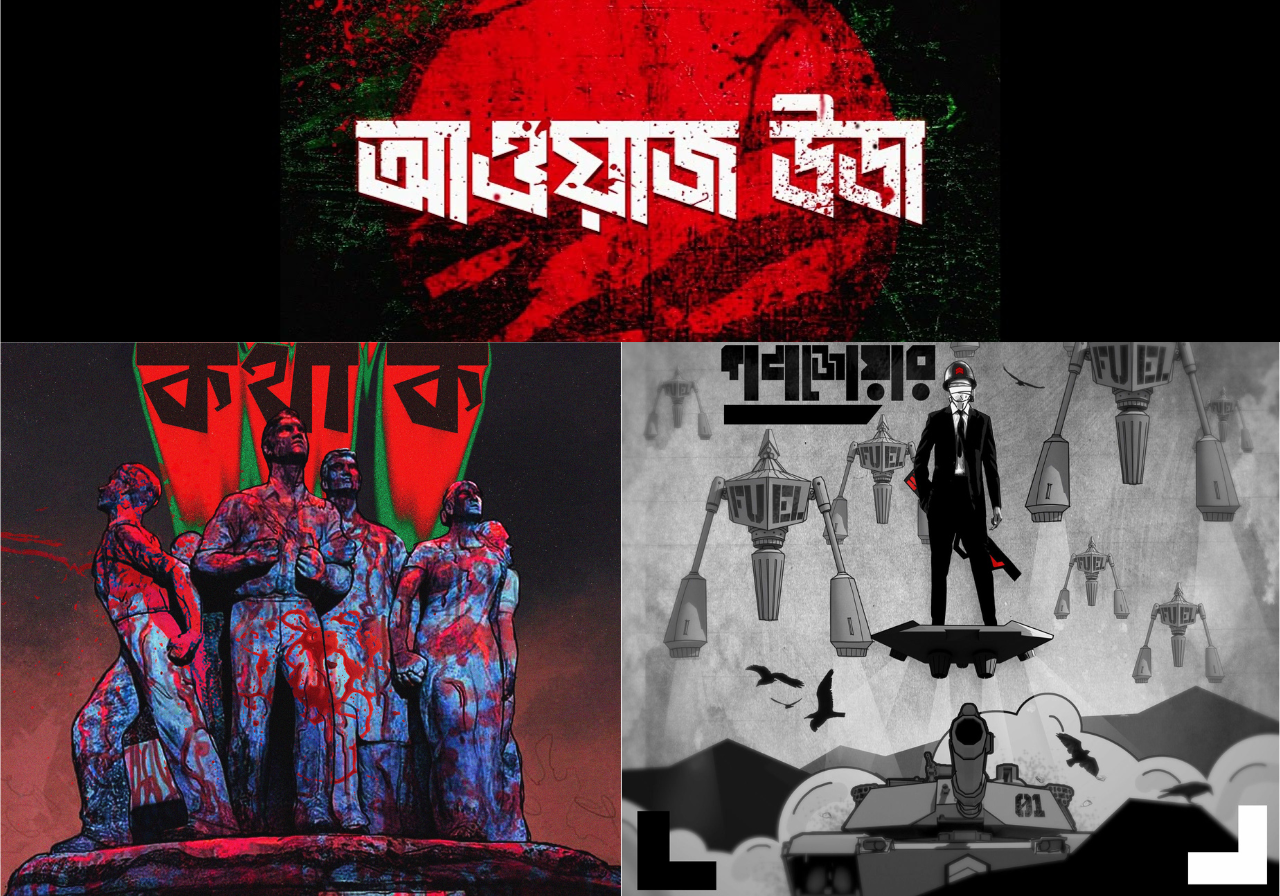By Adiba Hayat Rishova
When the streets of Bangladesh erupted in defiant unity last July, it wasn’t just chants and slogans that shook the ground — it was music too. Songs born of pain, rebellion and unyielding hope became the lifeblood of a movement that would ultimately topple a 15-year-old fascist regime.
In the face of bullets, tear gas and betrayal, people sang louder. From Bluetooth speakers in protest grounds to whispering hums behind closed doors, music stitched courage into the hearts of thousands.
Among these sonic beacons, a few rose to legendary status.
‘Kotha Ko’ by Shezan became a haunting lament turned rallying cry — a raw rap anthem of rage that took on new meaning in the crackdown of July. The song asked a defiant question of the regime:
“Deshta bole shadhin taile khechta koi re? Kotha ko!” (“Where is this so-called freedom? Tell us!”)
The lyrics, shouted from speakers and mouths alike, pierced through fear and silence. In nights filled with dread and uncertainty, protesters clung to each other and sang in harmony, reminding themselves that they were not alone.
Then came ‘Awaz Uda’ by Hannan — electric, furious and unfiltered. It didn’t ask questions. It made demands. Translating loosely to ‘raise your voice’, it became the soundtrack of student occupations and sieges on police barricades. So potent was its power, the regime arrested Hannan, hoping to silence the song’s fire, only to be reclaimed from police shackles once the regime surely fell.
Awaz Uda echoed back from the frontlines, shouted by young women whose hearts were painted with protest slogans, who had become the very image of resistance. It was theirs. It was everyone’s.
‘Gonojowar’ by Nemesis was something different. If Kotha Ko was introspection and Awaz Uda was fire, Gonojowar was the flood. Released in 2018, it surged back into the streets in 2024, becoming the heartbeat of the uprising. With lyrics calling for democracy and unity, it transcended class, region and creed. A song of the people, for the people.
Placards bearing the lyrics of Gonojowar — “Ei jeet amar odhikar / Ei haar tomar opochar” (“This victory is my right / This defeat is your crime”) and “Gonotonro, shobar montro…” (“Democracy, everyone’s mantra”) — struck a deep chord as protests swelled across the country. Though penned years earlier, the song found renewed purpose amid the uprising, echoing through the streets as if it had been written for this exact moment.
Then there was the song that became the viral, unfiltered voice of a generation’s frustration: “Desh ta ki tor baper naki” (“Is the country your father’s?”) written by renowned musician Ethun Babu. The phrase, often shouted at police and government officials, became a powerful and widely shared meme, hashtag and protest slogan. It was a digital and physical battle cry that encapsulated the collective rage against state-sanctioned corruption and the feeling of dispossession.
After the song went viral, the people behind Ehtun, Mousumi and Poran faced severe threats for their work and were even forced into hiding. Their minds were weighed down and their thoughts haunted by the disappearances and murders happening around them.
Yet perhaps the soul of the movement was best captured by Shunno’s 2020 hit ‘Shono Mohajan’. Written by celebrated lyricist Shahan Kabondho and produced by Fuad Al Muqtadir, the track wasn’t born of any explicit political agenda. It was a timeless lament — a plea against the tyranny of unchecked power. Originally a general outcry against authoritarianism, it transformed into a rallying cry for a generation resisting state-sponsored oppression.
Four years after its release, Shono Mohajan roared back to life — not on charts, but on protest grounds. Played over loudspeakers, stitched into reels and chanted in marches, it helped unmask the regime’s hollow narrative of justice and order during Bangladesh’s historic 36-day resistance.
In a movement led by the youth, Shono Mohajan became a bridge — between past and future, between colonial-era repression and a collective dream of liberation. Its echo was not just nostalgic, it was prophetic.
Together, Gonojowar and Shono Mohajan ignited a digital storm. Their lyrics became hashtags, their melodies viral backdrops to footage that local news refused to air. In the face of an orchestrated media blackout, these songs breathed life into online activism.
As protest videos went global, shared and translated by activists and diaspora communities, international media were finally forced to turn their eyes toward Bangladesh, just when we needed it most.
Across the country, these songs did more than inspire — they organised. Retaliation began with a chorus. Police raids were met with verse. Homes turned into sanctuaries where these anthems played on repeat, fueling resilience.
Parents who feared for their children’s safety came to recognise the lyrics. Street walls became canvases for graffiti, quoting their lines. These songs were more than sound — they were banners, battle cries and shields.
The July uprising was a turning point in Bangladesh’s history — not just a political revolt, but a cultural one too. A revolution carried out through sonic warfare. A battle of spirit fought not only with placards and protests, but with lyrics that could not be locked away in prison cells.
Now, a year later, with the old regime in exile and a reformed Bangladesh rising from the ashes, the songs remain. They are no longer just resistance anthems; they are archives etched in voice, memory and melody. These are the soundtracks to a people’s revolution — a sonic archive of defiance, grief and unshakable hope.


